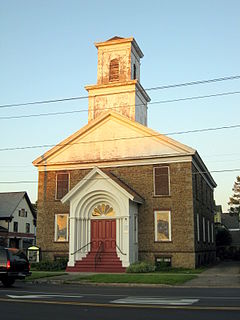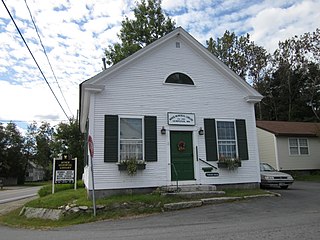
Mitchellville is a city located in Polk and Jasper counties in the U.S. state of Iowa. The population was 2,485 at the time of the 2020 census.

Unity Temple is a Unitarian Universalist church in Oak Park, Illinois, and the home of the Unity Temple Unitarian Universalist Congregation. It was designed by the American architect Frank Lloyd Wright, and built between 1905 and 1908. Unity Temple is considered to be one of Wright's most important structures dating from the first decade of the twentieth century. Because of its consolidation of aesthetic intent and structure through use of a single material, reinforced concrete, Unity Temple is considered by many architects to be the first modern building in the world. This idea became of central importance to the modern architects who followed Wright, such as Ludwig Mies van der Rohe, and even the post-modernists, such as Frank Gehry. In 2019, along with seven other buildings designed by Wright in the 20th century, Unity Temple was added to the UNESCO World Heritage List.

The First Unitarian Society of Madison (FUS) is a Unitarian Universalist congregation in Shorewood Hills, Wisconsin. Its meeting house was designed by Frank Lloyd Wright and built by Marshall Erdman in 1949–1951, and has been designated a U.S. National Historic Landmark for its architecture. With over 1,000 members, it is one of the ten largest Unitarian Universalist congregations in the United States.

The First Parish Church is a historic Unitarian Universalist church at Tremont and Depot Streets in Duxbury, Massachusetts. First Parish Church is currently a member congregation of the Unitarian Universalist Association.

The Unitarian Universalist Church of Medford and The Osgood House are a historic Unitarian Universalist church building and parsonage house at 141 and 147 High Street in Medford, Massachusetts.

The Unitarian Universalist Church of Cortland, New York, also known as "The Old Cobblestone Church," is an historic cobblestone church building located at 3 Church Street in Cortland, New York, United States. Built in 1837, the building was established as a Universalist church. Since 1961, the congregation has been a member of the Unitarian Universalist Association due to a denominational merger. The Unitarian Universalist Church of Cortland was listed on the National Register of Historic Places in 1993.

Bethel African Methodist Episcopal Church is a historic African American congregation and building in Iowa City, Iowa, United States. The congregation was established in 1868 mostly by free people of color from the south and the rest from the north. James W. Howard, a member of the congregation, bought property in a recent addition to the city and sold the southern half to the church for $50. This white frame church was built on the property the same year. Iowa City has always had a small African American community and over the years the congregation grew and declined in numbers and in finances. The original church, which is 600 square feet (56 m2) and has room for 50 people, was listed on the National Register of Historic Places in 2000. The congregation outgrew the small church and a new 4,000-square-foot (370 m2) sanctuary was built in 2010 that holds three times the current congregation's size.

Miner Memorial Library is the public library of Lempster, New Hampshire, located at 3 Second New Hampshire Turnpike. The library occupies a single-story wood-frame structure built in 1845 as a church for a Universalist congregation. Despite significant alteration for its use as a library, the building remains a fine example of vernacular church architecture in Sullivan County. Under the name First Universalist Chapel, the building was listed on the National Register of Historic Places in December 2006, and the New Hampshire State Register of Historic Places in January 2006.

Pittsfield Universalist Church is a historic church at 112 Easy Streets in Pittsfield, Maine. Built in 1898–99 with parts dating to 1857, it is one of the town's finest examples of Queen Anne architecture and is noted for its artwork and stained glass. The building was listed on the National Register of Historic Places in 1983.

The Guilford Center Meeting House, formerly the Guilford Center Universalist Church, is a historic building on Guilford Center Road in Guilford, Vermont. Built in 1837, it is a well-preserved example of transitional Greek Revival architecture. The building was added to the National Register of Historic Places in 1982. It is now owned by the local historical society as a community meeting and event space.

The First Universalist Church of Cedar Rapids, also called the Peoples Church Unitarian Universalist is listed on the National Register of Historic Places. Built in 1875, it served the Unitarian Universalist community of Cedar Rapids, Iowa, USA, for more than 135 years. Because of the high cost of upkeep and diminishing membership, the congregation voted to sell the building and grounds in May 2010. It was demolished in October 2011.

First Congregational Church is a congregation of the United Church of Christ located in Eldora, Iowa, United States. The congregation was organized in 1868 and the church building was individually listed on the National Register of Historic Places in 1996. In 2010 it was included as a contributing property in the Eldora Downtown Historic District in 2010.

Congregational United Church of Christ is located in the downtown area of Iowa City, Iowa, United States near the campus of the University of Iowa. The congregation was organized in 1856 and the church building was listed on the National Register of Historic Places in 1973. In 2004 it was included as a contributing property in the Jefferson Street Historic District.

Washington Prairie Methodist Church is a historic church building located southeast of Decorah, Iowa, United States. The congregation was established by Ole Peter Petersen. He returned to his native Norway in 1853 and founded the first Methodist congregation there. Washington Prairie Methodist is considered the mother church of Methodism in Norway. In the early years the congregation met in private houses. They built this church building themselves from 1863 to 1868. With its pediments and entablature/cornice it is Greek Revival in style. However, the windows on the side elevations are Gothic. It also features a round-arch entry on its gabled end. By 1888 services were only held here quarterly, and continued until about 1920, when the church was officially closed. Over the years some vandalism and settling of the structure occurred. The Vesterheim Norwegian-American Museum in Decorah restored the church and adjacent cemetery in 1972. The bishop of the North European Methodist Conference participated in its re-dedication later that year. It was listed on the National Register of Historic Places in 1980.

The Union Meetinghouse or Universalist Church is a historic church building at 97 Amesbury Road in Kensington, New Hampshire. Built in 1839–40, it is a well-preserved and little-altered example of a mid-19th century Greek Revival rural church. It was listed on the National Register of Historic Places in 2013, and continues to be used for summer services.

Ligonier Historic District is a national historic district located at Ligonier, Noble County, Indiana. The district encompasses 253 contributing buildings and 2 contributing objects in Ligonier. It developed between about 1835 and 1937, and includes notable examples of Italianate, Queen Anne, Gothic Revival, Classical Revival, and Bungalow / American Craftsman style architecture. Located in the district are the separately listed Ahavas Shalom Reform Temple and Jacob Straus House. Other notable buildings include the Dr. Enos Fenton Residence, Silas Shobe Residence, Eli Gerber Residence (1874), Oscar Parks Residence (1892), Solomon Mier Residence (1906), Simon Schloss Residence (1912), Gentry Hotel (1870), Straus Brothers Block (1888), Zimmerman Block, former Universalist Church (1856), First Presbyterian Church (1890), Ligonier Public Library (1908), Ligonier City Building (1914), U.S. Post Office (1935), Lyon and Greenleaf Flour Mill (1886), and former Mier Carriage Factory (1891).

Coralville Union Ecclesiastical Church, also known as Coralville Town Hall, is a historic building located in Coralville, Iowa, United States. It was listed on the National Register of Historic Places in 1977.

The former First Church of Christ, Scientist, also known as The City Church, is located in Cedar Rapids, Iowa, United States. Christian Science began in Boston in 1866 and it was introduced to Cedar Rapids twenty years later. A Sunday School was established in 1887 and it met at the old Dows Auditorium at Third Avenue and Third Street SE. The congregation was established in 1891 as an official branch of The First Church of Christ, Scientist in Boston. It was the first Christian Science congregation established in Iowa. They held their Wednesday evening services at the Peoples Unitarian Universalist Church. The congregation began construction on this building in 1914 and it was dedicated on Easter Sunday the following year. It is a red brick structure in the Neoclassical style. The rectangular building features a portico with four columns in the Doric order on the main facade, and a centered raised gable roof with cornice returns. The architectural style was chosen to "attract non-churchgoing people that may be intimidated by traditional religious structures." The congregation has subsequently moved to a new facility on Blairs Ferry Road, NE. This building was listed on the National Register of Historic Places in 2017.

First Unitarian Church is a historic building located in the downtown area of Iowa City, Iowa, United States. The local Universalist congregation traces its beginnings to 1841. Their building at Iowa Avenue and Dubuque Street was destroyed in a fire in 1868, and they built a larger building at Iowa Avenue and Clinton Street. In 1881 the Universalists merged with the local Unitarian Society. In their arrangement, the Unitarians paid for the minister while the Universalists owned the church building. The University of Iowa bought their building in 1907 and renamed it Unity Hall for use as a student union. The Unitarian-Universalist congregation dedicated this Tudor Revival building for their use on October 24, 1908. The dedication address was given by Rev. Eleanor E. Gordon, who was the secretary of the State Unitarian Conference of Iowa at the time. Because of their growth and costs to update the old building, the congregation voted in 2015 to build a new structure in near-by Coralville. They sold this building to developer Jesse Allen. It has subsequently been used as a winter shelter for the homeless while plans were made to include it in a new commercial-residential development. The former church building was listed on the National Register of Historic Places in 2018.






















